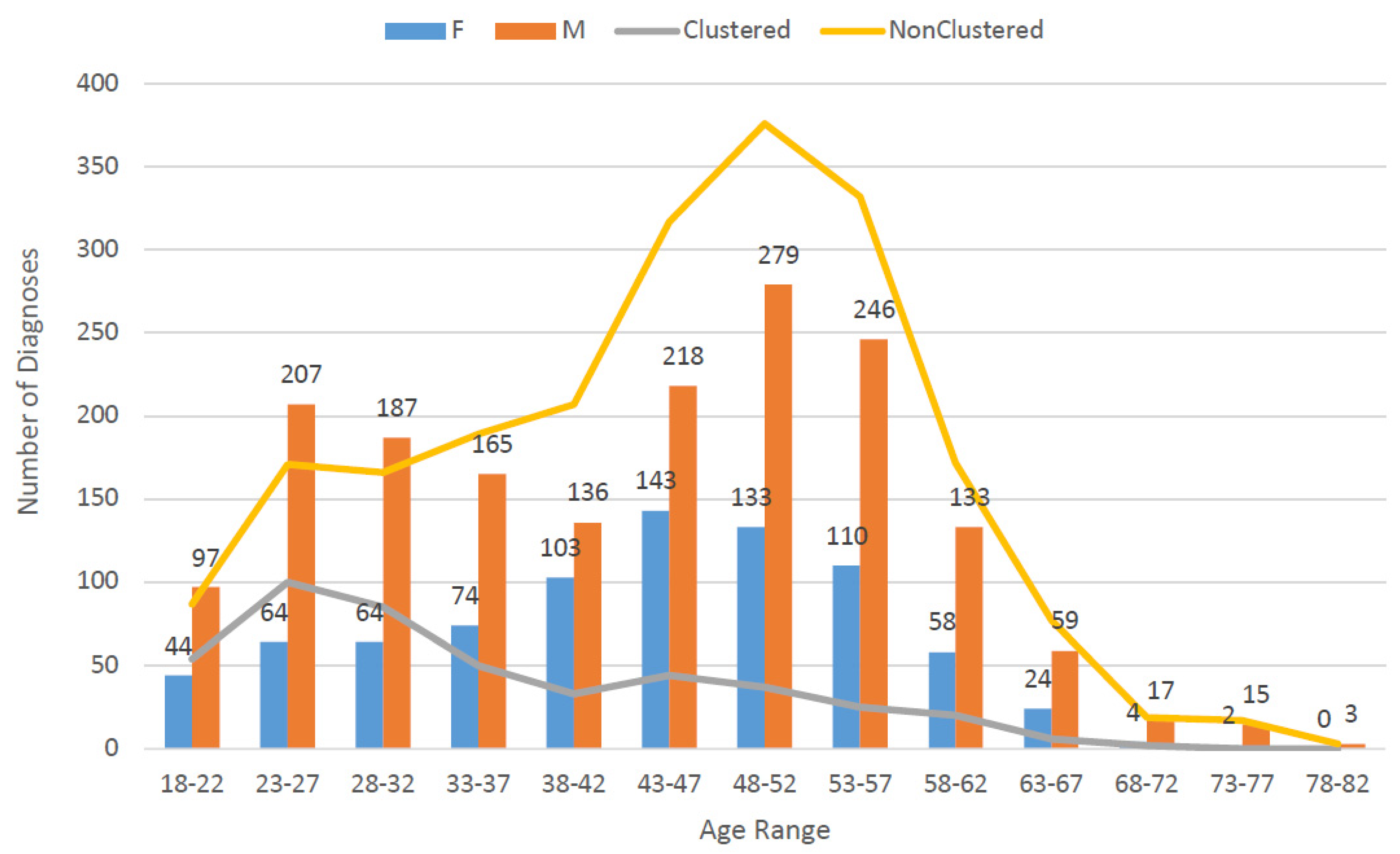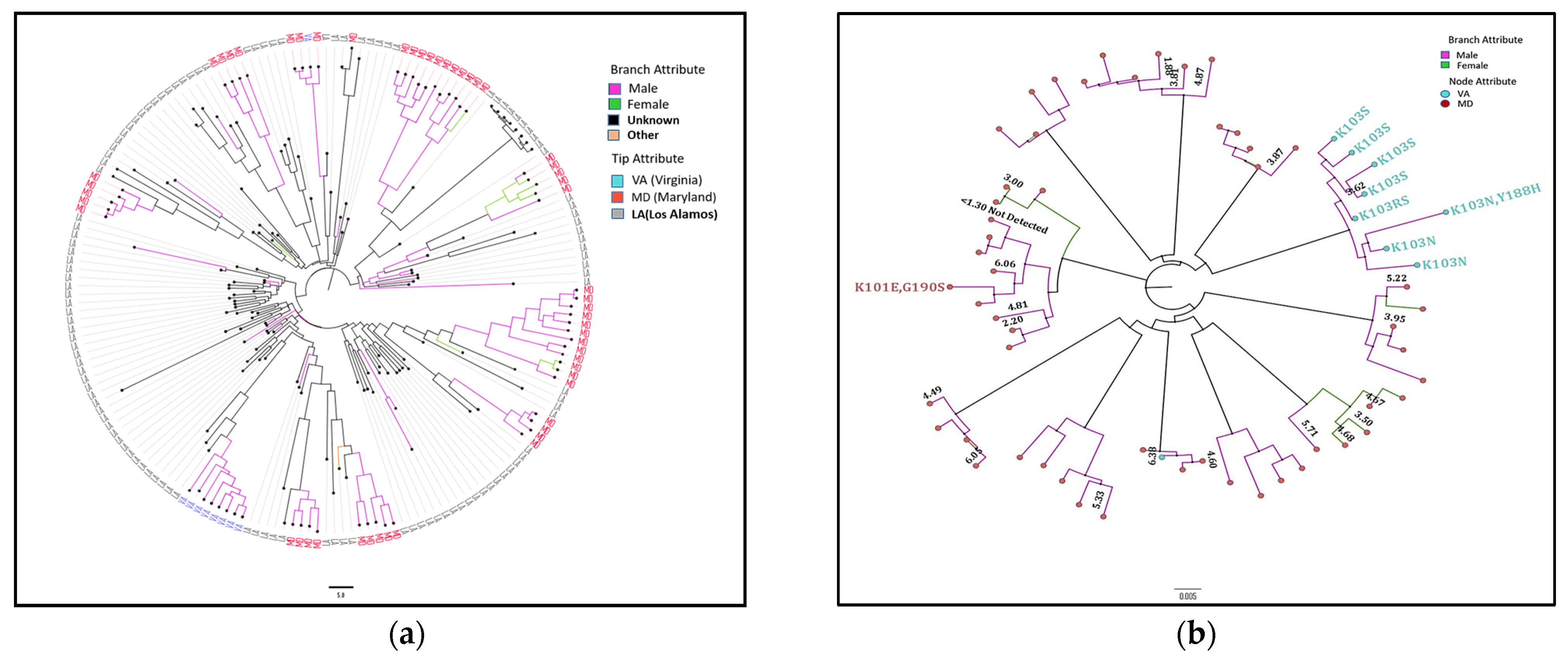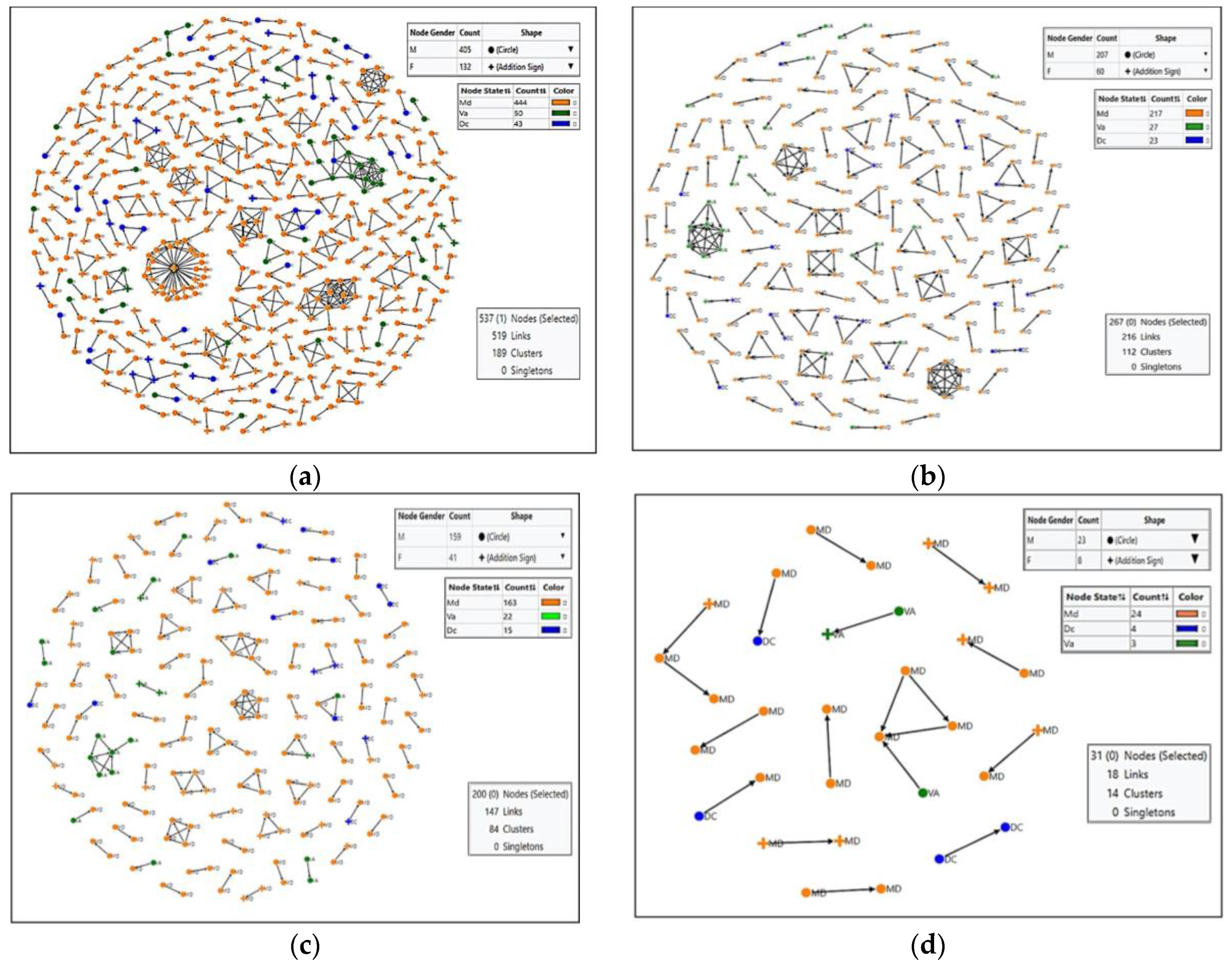Insights into HIV-1 Transmission Dynamics Using Routinely Collected Data in the Mid-Atlantic United States
Abstract
1. Introduction
2. Materials and Methods
2.1. Study Population
2.2. Sequence Alignment and Characterization
2.3. Cluster Analyses
2.3.1. Maximum Likelihood
2.3.2. Bayesian Analysis
2.3.3. Network Analysis
2.4. Statistical Analysis
2.5. Ethical Considerations and Disclosures
3. Results
3.1. Cluster Data
3.2. BEAST Analysis
3.3. Network Analysis
3.4. Transmission Clusters and Viremia
4. Discussion
5. Summary
Supplementary Materials
Author Contributions
Funding
Informed Consent Statement
Data Availability Statement
Acknowledgments
Conflicts of Interest
References
- Fauci, A.S.; Redfield, R.R.; Sigounas, G.; Weahkee, M.D.; Giroir, B.P. Ending the HIV Epidemic: A Plan for the United States. JAMA 2019, 321, 844. [Google Scholar] [CrossRef] [PubMed]
- Office of Infectious Disease and HIV/AIDS Policy, HHS. About Ending the HIV Epidemic in the U.S.: Priority Jurisdictions: Phase 1; Date Last Updated: 3 November 2020. Available online: https://www.hiv.gov/federal-response/ending-the-hiv-epidemic/jurisdictions/phase-one (accessed on 24 November 2021).
- Centers for Disease Control and Prevention. CDC Vital Signs. Ending the HIV Epidemic: HIV Treatment Is Prevention. 2019. Available online: https://www.cdc.gov/vitalsigns/end-hiv/pdf/vs-0318-end-hiv-H.pdf (accessed on 10 December 2021).
- Jenness, S.M.; Johnson, J.A.; Hoover, K.W.; Smith, D.K.; Delaney, K.P. Modeling an integrated HIV prevention and care continuum to achieve the Ending the HIV Epidemic goals. AIDS 2020, 34, 2103–2113. [Google Scholar] [CrossRef] [PubMed]
- Donnell, D.; Baeten, J.M.; Kiarie, J.; Thomas, K.K.; Stevens, W.; Cohen, C.R.; McIntyre, J.; Lingappa, J.R.; Celum, C. Heterosexual HIV-1 transmission after initiation of antiretroviral therapy: A prospective cohort analysis. Lancet Lond Engl. 2010, 375, 2092–2098. [Google Scholar] [CrossRef] [PubMed]
- Cohen, M.S.; Chen, Y.Q.; McCauley, M.; Gamble, T.; Hosseinipour, M.C.; Kumarasamy, N.; Hakim, J.G.; Kumwenda, J.; Grinsztejn, B.; Pilotto, J.H.; et al. Prevention of HIV-1 Infection with Early Antiretroviral Therapy. N. Engl. J. Med. 2011, 365, 493–505. [Google Scholar] [CrossRef]
- Cohen, M.S.; Chen, Y.Q.; McCauley, M.; Gamble, T.; Hosseinipour, M.C.; Kumarasamy, N.; Hakim, J.G.; Kumwenda, J.; Grinsztejn, B.; Pilotto, J.H.; et al. Antiretroviral Therapy for the Prevention of HIV-1 Transmission. N. Engl. J. Med. 2016, 375, 830–839. [Google Scholar] [CrossRef]
- Centers for Disease Control and Prevention. US Public Health Service: Preexposure Prophylaxis for the Prevention of HIV Infection in the United States—2021 Update: A Clinical Practice Guideline. Available online: https://www.cdc.gov/hiv/pdf/risk/prep/cdc-hiv-prep-guidelines-2021.pdf (accessed on 6 December 2022).
- Grant, R.M.; Lama, J.R.; Anderson, P.L.; McMahan, V.; Liu, A.Y.; Vargas, L.; Goicochea, P.; Casapía, M.; Guanira-Carranza, J.V.; Ramirez-Cardich, M.E.; et al. Preexposure Chemoprophylaxis for HIV Prevention in Men Who Have Sex with Men. N. Engl. J. Med. 2010, 363, 2587–2599. [Google Scholar] [CrossRef]
- Baeten, J.M.; Donnell, D.; Ndase, P.; Mugo, N.R.; Campbell, J.D.; Wangisi, J.; Tappero, J.W.; Bukusi, E.A.; Cohen, C.R.; Katabira, E.; et al. Antiretroviral Prophylaxis for HIV Prevention in Heterosexual Men and Women. N. Engl. J. Med. 2012, 367, 399–410. [Google Scholar] [CrossRef]
- Abbasi, J. Long-acting Cabotegravir Shot Prevents HIV Among Women. JAMA 2020, 324, 2247. [Google Scholar] [CrossRef] [PubMed]
- Little, S.J.; Pond, S.L.K.; Anderson, C.M.; Young, J.A.; Wertheim, J.O.; Mehta, S.R.; May, S.; Smith, D. Using HIV Networks to Inform Real Time Prevention Interventions. Harrigan PR, ed. PLoS ONE 2014, 9, e98443. [Google Scholar] [CrossRef]
- Wertheim, J.O.; Kosakovsky Pond, S.L.; Forgione, L.A.; Mehta, S.R.; Murrell, B.; Shah, S.; Smith, D.M.; Scheffler, K.; Torian, L.V. Social and Genetic Networks of HIV-1 Transmission in New York City. PLoS Pathog 2017, 13, e1006000. [Google Scholar] [CrossRef]
- Lubelchek, R.J.; Hoehnen, S.C.; Hotton, A.L.; Kincaid, S.L.; Barker, D.E.; French, A.L. Transmission Clustering Among Newly Diagnosed HIV Patients in Chicago, 2008 to 2011: Using Phylogenetics to Expand Knowledge of Regional HIV Transmission Patterns. JAIDS J. Acquir. Immune Defic. Syndr. 2015, 68, 46–54. [Google Scholar] [CrossRef] [PubMed][Green Version]
- Peters, P.J.; Pontones, P.; Hoover, K.W.; Patel, M.R.; Galang, R.R.; Shields, J.; Blosser, S.J.; Spiller, M.W.; Combs, B.; Switzer, W.M.; et al. HIV Infection Linked to Injection Use of Oxymorphone in Indiana, 2014–2015. N. Engl. J. Med. 2016, 375, 229–239. [Google Scholar] [CrossRef]
- Oster, A.M.; Lyss, S.B.; McClung, R.P.; Watson, M.; Panneer, N.; Hernandez, A.L.; Buchacz, K.; Robilotto, S.E.; Curran, K.G.; Hassan, R.; et al. HIV Cluster and Outbreak Detection and Response: The Science and Experience. Am. J. Prev. Med. 2021, 61, S130–S142. [Google Scholar] [CrossRef]
- District of Columbia Department of Health HIV/AIDS, Hepatitis, STD, and TB Administration. Annual Epidemiology and Surveillance Report; Data Through December 2019. 2020. Available online: https://dchealth.dc.gov/sites/default/files/dc/sites/doh/publication/attachments/2020-HAHSTA-Annual-Surveillance-Report.pdf (accessed on 26 July 2022).
- Singh, S.; Hu, X.; Hess, K. Estimating the Lifetime Risk of a Diagnosis of HIV Infection in the United States. 2022. Available online: https://www.croiconference.org/abstract/estimating-the-lifetime-risk-of-a-diagnosis-of-hiv-infection-in-the-united-states/ (accessed on 19 December 2022).
- Ocampo, J.M.F.; Smart, J.C.; Allston, A.; Bhattacharjee, R.; Boggavarapu, S.; Carter, S.; Castel, A.D.; Collmann, J.; Flynn, C.; Hamp, A.; et al. Improving HIV Surveillance Data for Public Health Action in Washington, DC: A Novel Multiorganizational Data-Sharing Method. JMIR Public Health Surveill. 2016, 2, e3. [Google Scholar] [CrossRef]
- Kassaye, S.G.; Grossman, Z.; Balamane, M.; Johnston-White, B.; Liu, C.; Kumar, P.; Young, M.; Sneller, M.C.; Sereti, I.; Dewar, R.; et al. Transmitted HIV Drug Resistance Is High and Longstanding in Metropolitan Washington, DC. Clin. Infect. Dis. 2016, 63, 836–843. [Google Scholar] [CrossRef] [PubMed]
- Gibson, K.M.; Steiner, M.; Kassaye, S.; Maldarelli, F.; Grossman, Z.; Perez-Losada, M.; Crandall, K.A. A 28-Year History of HIV-1 Drug Resistance and Transmission in Washington, DC. Front. Microbiol. 2019, 10, 369. [Google Scholar] [CrossRef] [PubMed]
- Gibson, K.M.; Jair, K.; Castel, A.D.; Bendall, M.L.; Wilbourn, B.; Jordan, J.A.; Crandall, K.A.; Pérez-Losada, M.; the DC Cohort Executive Committee. A cross-sectional study to characterize local HIV-1 dynamics in Washington, DC using next-generation sequencing. Sci. Rep. 2020, 10, 1989. [Google Scholar] [CrossRef]
- Kouyos, R.D.; von Wyl, V.; Yerly, S.; Böni, J.; Rieder, P.; Joos, B.; Taffé, P.; Shah, C.; Bürgisser, P.; Klimkait, T.; et al. Ambiguous nucleotide calls from population-based sequencing of HIV-1 are a marker for viral diversity and the age of infection. Clin. Infect. Dis. Off. Publ. Infect. Dis. Soc. Am. 2011, 52, 532–539. [Google Scholar] [CrossRef]
- Andersson, E.; Shao, W.; Bontell, I.; Cham, F.; Cuong, D.D.; Wondwossen, A.; Morris, L.; Hunt, G.; Sönnerborg, A.; Bertagnolio, S.; et al. Evaluation of sequence ambiguities of the HIV-1 pol gene as a method to identify recent HIV-1 infection in transmitted drug resistance surveys. Infect. Genet. Evol. J. Mol. Epidemiol. Evol. Genet Infect. Dis. 2013, 18, 125–131. [Google Scholar] [CrossRef]
- Sievers, F.; Wilm, A.; Dineen, D.; Gibson, T.J.; Karplus, K.; Li, W.; Lopez, R.; McWilliam, H.; Remmert, M.; Söding, J.; et al. Fast, scalable generation of high-quality protein multiple sequence alignments using Clustal Omega. Mol. Syst. Biol. 2011, 7, 539. [Google Scholar] [CrossRef]
- Rhee, S.Y.; Gonzales, M.J.; Kantor, R.; Betts, B.J.; Ravela, J.; Shafer, R.W. Human immunodeficiency virus reverse transcriptase and protease sequence database. Nucleic Acids Res. 2003, 31, 298–303. [Google Scholar] [CrossRef]
- Ragonnet-Cronin, M.; Hodcroft, E.; Hué, S.; Fearnhill, E.; Delpech, V.; Brown, A.J.L.; Lycett, S. Automated analysis of phylogenetic clusters. BMC Bioinform. 2013, 14, 317. [Google Scholar] [CrossRef]
- Nguyen, L.T.; Schmidt, H.A.; von Haeseler, A.; Minh, B.Q. IQ-TREE: A Fast and Effective Stochastic Algorithm for Estimating Maximum-Likelihood Phylogenies. Mol. Biol. Evol. 2015, 32, 268–274. [Google Scholar] [CrossRef] [PubMed]
- Drummond, A.J.; Rambaut, A. BEAST: Bayesian evolutionary analysis by sampling trees. BMC Evol. Biol. 2007, 7, 214. [Google Scholar] [CrossRef] [PubMed]
- Sayers, E.W.; Cavanaugh, M.; Clark, K.; Ostell, J.; Pruitt, K.D.; Karsch-Mizrachi, I. GenBank. Nucleic Acids Res. 2019, 48, D84–D86. [Google Scholar] [CrossRef]
- Drummond, A.J.; Ho, S.Y.W.; Phillips, M.J.; Rambaut, A. Relaxed Phylogenetics and Dating with Confidence. PLoS Biol. 2006, 4, e88. [Google Scholar] [CrossRef]
- Drummond, A.J.; Nicholls, G.K.; Rodrigo, A.G.; Solomon, W. Estimating Mutation Parameters, Population History and Genealogy Simultaneously from Temporally Spaced Sequence Data. Genetics 2002, 161, 1307–1320. [Google Scholar] [CrossRef]
- Minin, V.N.; Bloomquist, E.W.; Suchard, M.A. Smooth Skyride through a Rough Skyline: Bayesian Coalescent-Based Inference of Population Dynamics. Mol. Biol. Evol. 2008, 25, 1459–1471. [Google Scholar] [CrossRef]
- Kosakovsky Pond, S.L.; Weaver, S.; Leigh Brown, A.J.; Wertheim, J.O. HIV-TRACE (TRAnsmission Cluster Engine): A Tool for Large Scale Molecular Epidemiology of HIV-1 and Other Rapidly Evolving Pathogens. Mol. Biol. Evol. 2018, 35, 1812–1819. [Google Scholar] [CrossRef]
- Tamura, K.; Nei, M. Estimation of the number of nucleotide substitutions in the control region of mitochondrial DNA in humans and chimpanzees. Mol. Biol. Evol. 1993, 10, 512–526. [Google Scholar] [CrossRef]
- R Core Team. R: A Language and Environment for Statistical Computing; R Foundation for Statistical Computing: Vienna, Austria, 2020; Available online: https://www.R-project.org/ (accessed on 19 December 2022).
- Phillips, H.J. AHEAD: Monitoring Progress toward Achieving the Nation’s Viral Suppression Goals. Available online: https://www.hiv.gov/blog/ahead-monitoring-progress-toward-achieving-nation-s-viral-suppression-goals (accessed on 26 July 2022).
- Centers for Disease Control and Prevention. Monitoring Selected National HIV Prevention and Care Objectives by Using HIV Surveillance Data—United States and 6 Dependent Areas, 2019; HIV Surveillance Supplemental Report 2021, 26. Available online: http://www.cdc.gov/hiv/library/reports/hiv-surveillance.html (accessed on 21 December 2022).
- Quinn, T.C.; Wawer, M.J.; Sewankambo, N.; Serwadda, D.; Li, C.; Wabwire-Mangen, F.; Meehan, M.O.; Lutalo, T.; Gray, R.H. Viral Load and Heterosexual Transmission of Human Immunodeficiency Virus Type 1. N. Engl. J. Med. 2000, 342, 921–929. [Google Scholar] [CrossRef] [PubMed]
- Oster, A.M.; France, A.M.; Panneer, N.; Ocfemia, M.C.B.; Campbell, E.; Dasgupta, S.; Switzer, W.M.; Wertheim, J.O.; Hernandez, A.L. Identifying Clusters of Recent and Rapid HIV Transmission Through Analysis of Molecular Surveillance Data. J. Acquir. Immune Defic. Syndr. 2018, 79, 543–550. [Google Scholar] [CrossRef]
- Fisher, M.; Pao, D.; Brown, A.E.; Sudarshi, D.; Gill, O.N.; Cane, P.; Buckton, A.J.; Parry, J.V.; Johnson, A.M.; Sabin, C.; et al. Determinants of HIV-1 transmission in men who have sex with men: A combined clinical, epidemiological and phylogenetic approach. AIDS 2010, 24, 1739–1747. [Google Scholar] [CrossRef]
- Poon, A.F.Y.; Joy, J.B.; Woods, C.K.; Shurgold, S.; Colley, G.; Brumme, C.J.; Hogg, R.S.; Montaner, J.S.G.; Harrigan, P.R. The Impact of Clinical, Demographic and Risk Factors on Rates of HIV Transmission: A Population-based Phylogenetic Analysis in British Columbia, Canada. J. Infect. Dis. 2015, 211, 926–935. [Google Scholar] [CrossRef] [PubMed]
- Edelman, E.J.; Gordon, K.S.; Hogben, M.; Crystal, S.; Bryant, K.; Justice, A.C.; D. A. Fiellin for the VACS Project Team. Sexual Partner Notification of HIV Infection Among a National United States-Based Sample of HIV-Infected Men. AIDS Behav. 2014, 18, 1898–1903. [Google Scholar] [CrossRef]
- McClelland, A.; Guta, A.; Gagnon, M. The rise of molecular HIV surveillance: Implications on consent and criminalization. Crit. Public Health. 2020, 30, 487–493. [Google Scholar] [CrossRef]
- Dawson, L.; Benbow, N.; Fletcher, F.E.; Kassaye, S.; Killelea, A.; Latham, S.R.; Lee, L.M.; Leitner, T.; Little, S.J.; Mehta, S.R.; et al. Addressing Ethical Challenges in US-Based HIV Phylogenetic Research. J. Infect. Dis. 2020, 222, 1997–2006. [Google Scholar] [CrossRef]
- Mehta, S.R.; Schairer, C.; Little, S. Ethical issues in HIV phylogenetics and molecular epidemiology. Curr. Opin. HIV AIDS. 2019, 14, 221–226. [Google Scholar] [CrossRef]
- Sandset, T. The ethical and epistemological pitfalls of translating phylogenetic HIV testing: From patient-centered care to surveillance. Humanit Soc. Sci. Commun. 2020, 7, 19. [Google Scholar] [CrossRef]
- Ayala, G.; Bahati, M.; Balan, E.; Chang, J.; Do, T.D.; Fokeerbux, N.A.; Hassan, A.; Kerboghossian, J.; Poonkasetwatana, M.; Saavedra, J.; et al. Partner Notification: A Community Viewpoint. J. Int. AIDS Soc. 2019, 22, e25291. [Google Scholar] [CrossRef]



| Subtype B HIV-1 N = 2589 | Non-B Subtypes N = 186 | Total N = 2775 | ||
|---|---|---|---|---|
| Gender | Female | 823 | 105 | 928 |
| (31.8%) | (56.5%) | (33.4%) | ||
| Male | 1762 | 81 | 1843 | |
| (68.1%) | (43.5%) | (66.4%) | ||
| Not Reported | 4 | 0 | 4 | |
| (0.15%) | (0.14%) | |||
| State | DC | 232 | 10 | 242 |
| (9%) | (5.4%) | (8.7%) | ||
| MD | 1988 | 136 | 2124 | |
| (76.8%) | (73.1%) | (76.5%) | ||
| VA | 338 | 37 | 375 | |
| (13.1%) | (19.9%) | (13.5%) | ||
| Not Reported | 31 | 3 | 34 | |
| (1.2%) | (1.6%) | (1.2%) | ||
| Age | 18–37 years | 902 | 64 | 966 |
| (34.8%) | (34.4%) | (34.8%) | ||
| 38–52 years | 1014 | 91 | 1105 | |
| (39.1%) | (48.9%) | (39.8%) | ||
| ≥53 years | 673 | 31 | 704 | |
| (26.0%) | (16.6%) | (25.3%) | ||
| Ambiguity (Amb) * | Amb ≤ 0.5 | 643 | 29 | 672 |
| (24.8%) | (15.6%) | (24.2%) | ||
| Amb 0.5–0.99 | 443 | 26 | 469 | |
| (17.1%) | (13.9%) | (16.9%) | ||
| Amb ≥ 1 | 1503 | 130 | 1633 | |
| (58.1%) | (69.8%) | (58.8%) | ||
| Clustered Genetic Distance 3.0% | Female | 107 | 1 | 108 |
| (4.1%) | (0.5%) | (3.9%) | ||
| Male | 349 | 3 | 352 | |
| (13.5%) | (1.6%) | (12.7%) | ||
| Total | 456 | 4 | 460 | |
| (17.6%) | (2.2%) | (16.6%) | ||
| Clustered N = 456 | Non-Clustered N = 2133 | Total N = 2589 | Chi-Square | ||
|---|---|---|---|---|---|
| Gender | Female | 107 | 716 | 823 | p < 0.0001 |
| (23.5%) | (33.6%) | (31.8%) | |||
| Male | 349 | 1413 | 1762 | ||
| (76.5%) | (66.2%) | (68.1%) | |||
| Mean (SD) | 35.3 (12.1) | 44.7 (12.3) | 43 (12.8) | p < 0.0001 | |
| Age | 18–37 years | 289 | 613 | 902 | p < 0.00001 |
| (63.4%) | (28.7%) | (34.8%) | |||
| 38–52 years | 114 | 900 | 1014 | ||
| (25.0%) | (42.2%) | (39.2%) | |||
| ≥53 years | 53 | 620 | 673 | ||
| (11.6%) | (29.1%) | (26.0%) | |||
| Ambiguity (Amb) Score | Amb ≤ 0.5 | 202 | 442 | 644 | p < 0.00001 |
| (44.3%) | (20.7%) | (24.9%) | |||
| Amb 0.5–0.99 | 99 | 343 | 442 | ||
| (21.7%) | (16.1%) | (17.1%) | |||
| Amb ≥ 1 | 155 | 1348 | 1503 | ||
| (34.0%) | (63.2%) | (58.1%) | |||
| State | DC | 36 | 196 | 232 | p = 0.09 (NS) |
| (7.9%) | (9.2%) | (9%) | |||
| MD | 370 | 1618 | 1988 | ||
| (81.1%) | (75.9%) | (76.8%) | |||
| VA | 48 | 290 | 338 | ||
| (10.5%) | (13.6%) | (13.1%) | |||
| NR | 2 | 29 | 31 | ||
| (0.4%) | (1.4%) | (1.2%) | |||
| Cluster Data | HIV Viral Load (VL) | |||
|---|---|---|---|---|
| Number of HIV VL Tests N = 1394 | Median in log10 Copies/mL (IQR 25–75%) | ≥3.0 log10 c/mL | <3.0 log10 c/mL | |
| Overall HIV VL | 1394 | 4.4 (3.2–4.99) | 1091 (78.3%) | 303 (21.7%) |
| Cluster size ≥ 4 (N = 62) | 21 | 4.6 (3.8–5.2) | 18 (85.7%) | 3 (14.3%) |
| Cluster size 3 (N = 96) | 47 | 3.1 (2.3–4.6) | 26 (55.3%) | 21 (44.7%) |
| Cluster size 2 (N = 298) | 161 | 4.0 (2.1–4.8) | 111 (68.9%) | 50 (31.1%) |
| Cluster size 2 and 3 (N = 394) | 208 | 3.9 (2.2–4.8) | 137 (65.9%) | 71 (34.1%) |
| Not in clusters (N = 2133) | 1169 | 4.4 (3.3–5.0) | 927 (79.3%) | 242 (20.7%) |
Disclaimer/Publisher’s Note: The statements, opinions and data contained in all publications are solely those of the individual author(s) and contributor(s) and not of MDPI and/or the editor(s). MDPI and/or the editor(s) disclaim responsibility for any injury to people or property resulting from any ideas, methods, instructions or products referred to in the content. |
© 2022 by the authors. Licensee MDPI, Basel, Switzerland. This article is an open access article distributed under the terms and conditions of the Creative Commons Attribution (CC BY) license (https://creativecommons.org/licenses/by/4.0/).
Share and Cite
Kassaye, S.G.; Grossman, Z.; Vengurlekar, P.; Chai, W.; Wallace, M.; Rhee, S.-Y.; Meyer, W.A., III; Kaufman, H.W.; Castel, A.; Jordan, J.; et al. Insights into HIV-1 Transmission Dynamics Using Routinely Collected Data in the Mid-Atlantic United States. Viruses 2023, 15, 68. https://doi.org/10.3390/v15010068
Kassaye SG, Grossman Z, Vengurlekar P, Chai W, Wallace M, Rhee S-Y, Meyer WA III, Kaufman HW, Castel A, Jordan J, et al. Insights into HIV-1 Transmission Dynamics Using Routinely Collected Data in the Mid-Atlantic United States. Viruses. 2023; 15(1):68. https://doi.org/10.3390/v15010068
Chicago/Turabian StyleKassaye, Seble G., Zehava Grossman, Priyanka Vengurlekar, William Chai, Megan Wallace, Soo-Yon Rhee, William A. Meyer, III, Harvey W. Kaufman, Amanda Castel, Jeanne Jordan, and et al. 2023. "Insights into HIV-1 Transmission Dynamics Using Routinely Collected Data in the Mid-Atlantic United States" Viruses 15, no. 1: 68. https://doi.org/10.3390/v15010068
APA StyleKassaye, S. G., Grossman, Z., Vengurlekar, P., Chai, W., Wallace, M., Rhee, S.-Y., Meyer, W. A., III, Kaufman, H. W., Castel, A., Jordan, J., Crandall, K. A., Kang, A., Kumar, P., Katzenstein, D. A., Shafer, R. W., & Maldarelli, F. (2023). Insights into HIV-1 Transmission Dynamics Using Routinely Collected Data in the Mid-Atlantic United States. Viruses, 15(1), 68. https://doi.org/10.3390/v15010068










